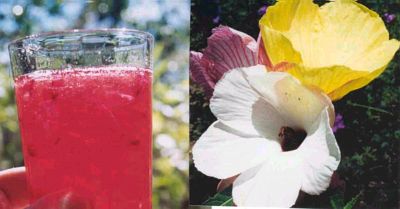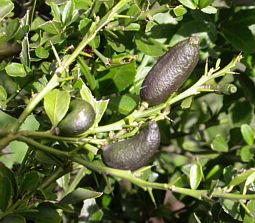| |
| Eating and Drinking the Garden - Recipes |
Lemon Myrtle Drink
To make 2 litres of lemon myrtle drink, take 4 fresh young lemon myrtle leaves. Pour over a small quantity of boiling water. Let cool. Add cooled, strained liquid to a 2 litre bottle of cold water. The flavour keeps coming out for several days so further drinks can be made by adding fresh water to the leaves. The water which is added to the leaves does not need to be hot.
To make a hot drink, add 1/2 leaf to a cup of boiling water. Let sit for 5 minutes.
|
|
Lemon Myrtle Syrup
| |
 |
Although we had been using the young leaves of lemon myrtle for many years to make both hot and cold drinks, we had not thought of this species for the ingredients for a long-lasting syrup. However, when we tried to find a crop that was available in early winter, we realised that syrup from the leaves of lemon myrtle could be made at any time of the year. (Photo: Geoff Keena)
|
|
* 5 grams of lemon myrtle leaves
* 1 1/4 cups of boiling water
* 1 1/4 cups of sugar
Roughly chop lemon myrtle leaves. Pour over boiling water. When mixture has cooled, discard leaves and mix the water and sugar together. Bring mixture to the boil. Lower heat and simmer gently until the volume is reduced by a third. Pour into a sterilised jar and store in the fridge.
Delicious over ice-cream or with custard or fruit.
|
Australian Native Hibiscus Preserve
This recipe produces a rich red spread with the consistency of honey. It has a distinctive flavour and is delicious on toast or scones or raisin toast. Can be used as a glaze or diluted with white vinegar for sauces or marinades.
| |

Hibiscus jam shown with blooms of Hibiscus heterophyllus (white, pink, yellow). All colours make a rich red preserve which is delicious on toast or scones (Photo: Geoff Keena).
|
|
(Microwave Method: Times based on 600 watts on high - adjust as needed):
* Petals only from 10 large hibiscus flowers
* 1/4 cup of lemon juice
* 1/2 cup of boiling water
* 2 cups of sugar
Detach petals from calyx and discard calyx. Chop petals finely and place in a very deep pyrex bowl. Cover petals with lemon juice and microwave on high for 4 minutes. Add boiling water and sugar and stir well.
Cook 2 minutes then stir. Cook another 2 minutes, stir and then cook 2 minutes more. Stir. Let cool for an hour. When cool, cook for 2 minutes then stir. Test if preserve gels by placing a small amount on a cold plate. If needed, continue cooking but no more than 1 minute at a time. Let cool slightly and pour into a sterilised jar. Seal, turn the jar upside down for 2 minutes to sterilise the lid..
|
| |

At the time of writing, this Citrus australasica, a grafted plant, now in its second year of cropping, has given enough finger limes for forty batches of Wild Lime Syrup. The seedling of at least the same age, although the same height, has not had one lime and is about to be replaced by another grafted plant (Photo: Geoff Keena).
|
|
Wild Lime Syrup
Reference: Based on a recipe in Wild Classics by Juleigh and Ian Robbins, Allen & Unwin, 2000.
Makes about 500 ml.
* 1 1/4 cups of white sugar
* 1 cup of water
* 1/4 cup of wild limes, chopped, e.g. finger limes, Citrus australasica.
Place water and sugar into a heavy-based saucepan and heat until the sugar has dissolved. Add the wild limes and bring to the boil. Lower heat and simmer gently until the volume is reduced by a third (about an hour). Remove from the heat and strain through a fine sieve to remove the fruit. The syrup may be put in sterile jars or bottles and sealed while still hot. This syrup will keep for 12 months.
Note: The longer the syrup is reduced, the darker it will become and the flavour will intensify. Different batches can be reduced to different strengths and are delicious served together, e.g. over custard or ice-cream as the different intensities of colour and flavour add more interest and enjoyment.
|
[Return to Eating and Drinking the Garden]
|
|